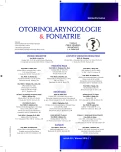-
Medical journals
- Career
Diagnostics of Meniere’s Disease by Objective Methods of Examination
Authors: S. Krempaská; J. Kovaľ; J. Mihaľková
Authors‘ workplace: Klinika otorinolaryngológie a chirurgie hlavy a krku UNLP, Košice primár prof. MUDr. J. Kovaľ, CSc.
Published in: Otorinolaryngol Foniatr, 65, 2016, No. 1, pp. 3-8.
Category: Original Article
Overview
Meniere’s disease in a disease, which is characterized by three basic symptoms: vertigo hearing disorders and “humming” and/or feeling of pressure in the ear. The diagnostics of Meniere’s disease is increasingly based on symptomatology and clinical course of the disease rather than the results of objective tests. Although an objective test, which could diagnose Meniere’s disease univocally, is still missing and in order to confirm or exclude under the diagnosis all circumstances, attention is more and more paid to the possibility of using objective methods of examination. The authors examined, in the course of two years, 82 patients, where Meniere’s disease was supposed to occur. The patients were divided to three groups: the established Meniere’s disease (34 patients) probable Meniere’s disease (24 patients) and possible Meniere’s disease (24 patients).
The paper describes the results of examination is these patients – oto-acoustic emissions, stem evoked potentials, analysis of the results of evoked potentials by means of auditory masking, examination of vestibular evoked potentials, caloric tests, electrocochleography Meniere’s, and NMR examinations.
In our opinion, the examination of patients with Meniere’s disease by means of objective methods of examination is a standard diagnostic procedure. The evaluation of all results accents the precision of diagnosis establishment and contributes to diagnosis of early stage of the disease. The early discovery extends the possibilities of selecting a broader spectrum of therapy and postpones definitive changes in the sensory epithelium of inner ear.KEYWORDS:
Meniere’s disease, vertigo, tinnitus, hypoacusis, objective examination methods, VEMP, OAE, BERA, CHAMP, ECoChg (electrocochleograpy), caloric test
Sources
1. Akkuzu, G., Akkuzu, B., Ozluoglu, L. N.: Vestibular evoked myogenic potentials in benign paroxysmal positional vertigo and Meniere´s disease. Eur. Arch. Otorhinolaryngol., 263, 2006, 2, s. 510-517.
2. Brookes, G. B.: Circulating immune complex in Meniere´s disease. Arch. Otolaryngol. Head Neck Surg., 112, 1968, 5, s. 536-540.
3. Committee on Hearing and Equilibrium guidelines for the diagnosis and evaluation of therapy in Meniere´s disease. American Academy of Otolaryngology and Head and Neck Surgery Foundation. Otolaryngol Head Neck Surg., 113, 1995, 3, s. 181-185.
4. De Valck, C. F. J., Claes, G. M. E., Wuyts, F. L., Van de Heyning, P. H.: Lack of diagnostic Value of High-Pass Noise Masking of Auditory Brainstem Responses in Meniere´s disease. Otol. Neurotol., 28, 2007, 5, s. 700-707.
5. Fransen, E., Verstreken, M., Verhagen, W. I. M. et al.: High prevalence of symptoms of Meniere´s disease in three families with mutation in the COCH gene. Human Molecular Genetics., 8, 1999, 8, s. 1425-1429.
6. Gibson, W. P. R., Moffat, D. A., Ramsden, R. T.: Clinical electrocochleography in the diagnosis and management of Meniere´s disorder. Audiology, 16, 1977, s.389-341.
7. Kim, H. H., Kumar, A., Battista R. A., Wiet R. J.: Electrocochleography in patiens with Meniere´s disease. Am. J. Otolarygol., 90, 1995, 2, s. 1797-1803.
8. Krempaská, S., Kovaľ, J.: The role of vestibular evoked myogenic potentials (VEMs) in vestibulopathy diagnostics. Bratisl. Lek. Listy, 113, 2012, 5, s. 301-306.
9. Levine, S., Margolis, R. H., Daly, K. A.: Use of elektrocochleography in the diagnosis of Meniere´s disease. Laryngoscope, 108, 1998, 7, s. 993-1000.
10. Magliulo, G., Parrotto, D., Gagliardi, S. et al.: Vestibular evoked periocular potentials in Meniere´s disease After glycerol testing. Ann. Otol. Rhinol. Laryngol., 117, 11, s. 800-804.
11. Merchant, S. N., Adams, J. C., Nadol Jr, J. B.: Pathophysiology of Meniere´s syndroma: Are symptoms caused by endolymphatic hydrops? Otol. Neurotol., 26, 2005, 1, s. 74-81.
12. Pichanič, M.: Klinická vestibulológia. Martin, Osveta, 1992, 336 s.
13. Semaan, M. T., Alagraman, K. N., Megerian, C. A.: The basic science of Meniere´s disease and endolymphatic hydrops. Curr. Opin. Otolaryngol. Head Neck Surg., 13, s. 301-337.
14. Van Huffelen, W. M., Mateijsen, N. J. M., Wit, H. P.: Classification of patients with Menire´s disease using Otoacoustic Emissions. Audiol. Neurootol., 3, 1998, s. 419-430.
15. Vassiliou, A., Vlastarakos, P. V., MAragoudakis, P., CAndiloros, D., Nikolopoulos, T. P.: Meniere´s disease: Still a mystery disease with difficult differential diagnosis. Ann. Indian Acad. Neurol., 14, 2011, s. 8-12.
Labels
Audiology Paediatric ENT ENT (Otorhinolaryngology)
Article was published inOtorhinolaryngology and Phoniatrics

2016 Issue 1-
All articles in this issue
- Drug-Induced-Sleep-Endoscopy, DISE
- Nasal Packing – Survey of Materials
- Visual Reinforcement Audiometry. Behavioral Method for Hearing Examination in Small Children
- Clinical Use of a New Audiometric Nethod – Visual Reinforcement Audiometry
- Significance of C kit and MYB Gene Expression for Diagnosis, Prognosis and Treatment of Adenoid Cystic Carcinoma of the Salivary Glands- the Current Level of Research and Its Application in Clinical Practice
- Mucosal Malignant Melanoma of the Nasal Cavity
- Diagnostics of Meniere’s Disease by Objective Methods of Examination
- Quality of Life in Patients with Head and Neck Cancer in the Course of Three Years of Observation in a Nutritional Outpatient Department
- Microbiological Findings in Children with Adeno-Tonsillar Hypertrophy
- Peritonsillar Complications of Acute Inflammations of Palatine Tonsils (a Retrospective Study)
- Otorhinolaryngology and Phoniatrics
- Journal archive
- Current issue
- Online only
- About the journal
Most read in this issue- Nasal Packing – Survey of Materials
- Peritonsillar Complications of Acute Inflammations of Palatine Tonsils (a Retrospective Study)
- Diagnostics of Meniere’s Disease by Objective Methods of Examination
- Drug-Induced-Sleep-Endoscopy, DISE
Login#ADS_BOTTOM_SCRIPTS#Forgotten passwordEnter the email address that you registered with. We will send you instructions on how to set a new password.
- Career

